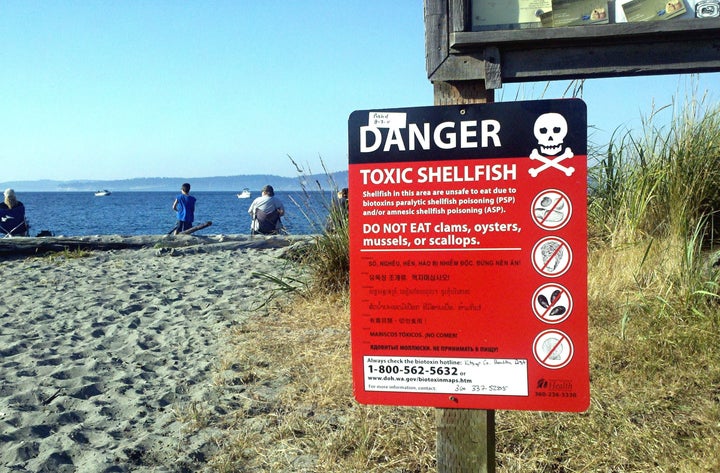
The bright red skull-and-crossbones signs are hard to miss and increasingly common on Pacific Northwest beaches. A whole new fleet just popped up along the shores of a small bay between the Pacific Ocean and Puget Sound.
On Friday, Washington State health officials reported the first U.S. illnesses linked to one particular strain of toxin triggered by an algal bloom. Three people came down with Diarrhetic Shellfish Poisoning (DSP) after eating mussels from Sequim Bay, in the Strait of Juan de Fuca. The bay is now closed to shellfish harvesting.
Although the culprit biotoxin hadn't been previously detected at unsafe levels in U.S. shellfish, thousands of people in Europe, Asia and South America have reportedly suffered its unpleasant gastrointestinal symptoms in recent years. The long-term health effects from DSP are not yet clear; some experts think they might include an increased risk of cancer.
"Whether this is really the first case of poisoning here, we don't know," said Vera Trainer, program manager of the Marine Biotoxin Group at NOAA's Northwest Fisheries Science Center in Seattle. "But it certainly looks to me like things are getting worse."
Harmful algal blooms, often called red tides, can occur naturally in both marine or fresh waters, and have been a recognized public health threat since well before humans began significantly altering the environment. In the late 1700s, members of Capt. George Vancouver's exploration crew died after eating mussels contaminated with another toxic strain, Paralytic Shellfish Poisoning (PSP).
Still, experts suggest that some of the toxins released by various algae species are becoming more prevalent, frequent and virulent across the U.S. from the Oregon coast to Chesapeake Bay. They have been known to pose a range of threats to marine environments, local economies and public health.
"The strongest algal blooms occur during very hot weather, where there is lots of sun and not a whole lot of wind," explained Chris Moore of the nonprofit Chesapeake Bay Foundation. He pointed to this summer's extreme heat along the east coast as "perfect bloom conditions," and suggested that the high temperatures may have played a role in what continues to be a particularly problematic algal bloom season in Maryland. The local strain does not produce any toxins, but rather suffocates fish and oysters by clogging their gills. But what Moore calls "mahogany tides" can cause devastating damage to economies dependent on the shellfish.
Excess nutrients entering the waterway, including fertilizers, pet waste and sewage, might also contribute to the proliferation of the microscopic marine plants. "A heavy rainfall could produce the last slug of nutrients for algae to start blooming in mass," said Moore.
While experts expect climate change to bring both warmer waters and episodes of heavier rains, they are cautious about making a direct link between global and local phenomena. The role of pollution, and why these microorganisms produce the poisons in the first place, also remains unclear.
What does seem clear is that the Pacific Northwest in particular is getting flooded with the toxins and their consequences: DSP joins the region's potentially fatal PSP and amnesic shellfish poisoning (ASP) strains.
"Poor Puget Sound seems to have pretty much everything," says Trainer. "Although the Florida Red Tide has not yet come out here."
That Florida Red Tide produces a biotoxin that can cause non-fatal Neurotoxic Shellfish Poisoning (NSP) through ingestion as well as respiratory troubles through inhalation, in addition to killing fish, marine mammals and seabirds en masse.
While the Florida Red Tide and other algal blooms are often colored a shade of red -- or purple, brown or green -- the term can be a misnomer. Just because the water turns an odd color doesn't mean it will make people sick, though beaches may become less than appealing, like when a bright green bloom took over a beach in Qingdao, China in July.
And microorganisms don't need to concentrate in color-changing levels in order to cause harm. Shellfish that feed upon low levels of them over a prolonged period of time still accumulate enough poison to sicken human consumers.
Researchers are just now starting to understand why the algae excrete the physiologically expensive toxin. "They don't produce it to harm to fish and human, but rather to have better success in their environment," pointed out William Cochlan, senior research scientist of marine microbial ecology and oceanography at San Francisco State University. "How does the toxin make their life better?"
So far, Cochlan's research has suggested that the toxins may allow single-celled organisms to more easily acquire essential elements, such as iron or copper, from the water.
His research lab has also found that the nutrients associated with man-made activities, such as sewage and agricultural fertilizer, only cause certain species of algae to become more toxic. "We cannot generalize to all toxin-producing species," said Cochlan.
"If we can understand what the toxin does, then we can figure out ways that the cell can be happy without the toxin, and ensure that the people and the environment aren't harmed by the species," he added.
That knowledge could increase researchers' ability to monitor coastal areas, and quickly close them before an algal bloom begins to cause harm.
This might then also allow lucrative fisheries to stay open longer. California, for example, shuts down all coastal areas for recreational mussel harvesting between May and October as a precaution. In the Pacific Northwest, many Native Americans living off of Sequim Bay rely on selling shellfish for subsistence.
"They want to know when they can harvest again," said Trainer.
